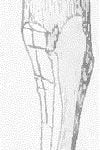
The new fire rite performed at sunrise of the second day, is symbolic of a new period of life for the tribe. As far as could be learned, the fires of the various household hearths are not extinguished as among the Creeks, since the kindling of the new fire by the town chief is symbolical of this and suffices for all. The ceremonial method of starting this fire was explained before, so it need not be repeated. The logs in the center of the square-ground were ignited from the fire started in the punk and kept burning until the ceremony is over, by the proper official. The fire making implements were kept in a bag which hung during the ceremony, along with the rattles when not in use, on the middle post at the front of the town chief’s lodge, just over where he sat.
The fireplace had been swept clean and covered with sand. The yatcigi now walked sunwise around the spot three times, then stopped, each one standing at one of the cardinal points. They deposited the four logs with their ends pointing toward the cardinal points thus -|- , then retired to the west lodge behind the town chief. He ‘A as now preparing punk and fire materials, having taken them from his bag suspended from the post near his head. He struck the fire into a tray of bark filled with dried pith, in the manner described elsewhere. (See Plate XIII, 1) When the spark had sprung into a flame the yatcigi’ took the tray, and ignited sticks between the logs and thus the new fire for the new year was started. They concluded by walking four times around it. 1) During this time at intervals a few taps were given on the water-drum.
In the meantime a post had been erected in the southeast corner of the square as a sign that women, dogs and aliens, also those who have eaten corn that season or tasted food since the previous evening. Were prohibited from the square under penalty of violence at the hands of the yatcigi. It is also said that in war times captives were bound to this stake when they were to be burned to death. 2
The medicine plants, red root, to tcalá, and button-snake root, ƒeâde’, were now brought by the yätcigi’, who walked around the fire with them five times, and then lay them lengthwise, with roots to the east and foliage to the west, in a space about fifteen feet east of the fire, where a halved log was laid on which to crush them. Two crocks, formerly pots of a high shape, were brought full of water and stood in front of the medicines. Kneeling before the pots the yätcigi’ pomaded up the roots and stems with pounders about fourteen inches long, made from peeled branches (Fig. 39). (See Plate XIII, 2.) The crushed roots were then put in the crocks while the stems were thrown behind the north lodge, with the pounders, upon the heap of sacred debris there.
Citations:
- At this time in the cognate Creek and Cherokee ceremony, each family swept its hearth and started a new fire from the public embers, but the Yuchi symbolized this for the whole town by their public new fire. (19th Report Bureau American Ethnology, p. 402; Cherokee Myths, Mooney; Gatschet, Creek Migration Leg., Vol. II, p. 189 for Kasixta town; Speck, Creek Indians of Taskigi Town, p. 142 for Taskigi town.[
]
- Also noticed by Bartram among Creeks (cf. Bartram’s Travels, p. 518), but in that case there were four stakes, one at each corner of the square.[
]
